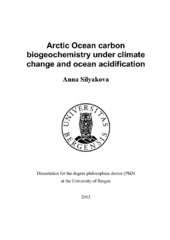| dc.contributor.author | Silyakova, Anna | eng |
| dc.date.accessioned | 2013-06-27T08:30:07Z | |
| dc.date.available | 2013-06-27T08:30:07Z | |
| dc.date.issued | 2013-05-10 | eng |
| dc.identifier.isbn | 978-82-308-2278-4 | en_US |
| dc.identifier.uri | https://hdl.handle.net/1956/6744 | |
| dc.description.abstract | Human-induced CO2 emissions to the atmosphere cause climate change and ocean acidification. The strongest indicators of climate change and ocean acidification are expected to be found in the Arctic Ocean (AO). The AO area is small compared to the world ocean, but the global influence of its carbon biogeochemical system with large spatial and temporal variability is considerable and complex. The AO carbon biogeochemical system is also expected to experience feedback in regard to climate change, and to influence the energy flow throughout the Arctic food web. This thesis investigates the carbon biogeochemical system in the AO: present variability; coupling with processes at the low trophic level; and response to future climate and CO2 scenarios. The study combines differing methodological approaches: (i) in-situ observations, (ii) field perturbation experiments, and (iii) ecosystem modeling. The thesis is based on four separate papers. Paper I describes the natural variability of particulate organic carbon and particulate organic nitrogen in a composition of seston and estimates the carbon to nitrogen (C:N) ratio in the AO seston. The paper is based on 3672 in-situ measurements gathered from sources both published and unpublished. The overall C:N ratio in seston was 7.4, which is significantly higher than the classical Redfield ratio of 6.6. A great regional variability in the seston C:N ratio was found. Paper II introduces the inorganic carbonate system around the Svalbard archipelago in the AO, at present and under future climate and CO2 scenarios. This paper is based on results from a coupled physical-biogeochemical ecosystem model forced by SRES A1B scenario, as well as on results of a CO2 perturbation study on the natural community conducted in an Arctic fjord. The results presented in this paper suggest that seawater pCO2 in the area around Svalbard at the end of the 21st century will be 300 μatm higher than at present in the Atlantic influenced region, and 400 μatm higher than at present in the Arctic influenced region. As a result, the waters in the Arctic-influenced region will be undersaturated with respect to aragonite, and waters in the Atlantic-influenced region will be close to the undersaturation state. The modeled summer decrease in seawater pCO2, and the increase in pH and aragonite saturation state are all steeper in the future. This was also observed during an experiment on ocean acidification in natural phytoplankton assemblage, which was perturbed with the projected high levels of seawater pCO2. Paper III is based on results from two model simulations, performed with the coupled physical-biogeochemical ecosystem model forced by SRES A1B scenario, parameterized with the constant C:N ratio and with the pCO2 sensitive C:N ratio. The paper demonstrates that more inorganic carbon could be fixed by autotrophs in the future surface Arctic waters if annual primary production increases in response to the pCO2 sensitive C:N ratio. As a result of higher primary production, and consequently higher export production in case of pCO2 sensitive C:N ratio, more carbon is released below the euphotic zone, which leads to lower pH and aragonite saturation states than in case with the constant C:N ratio. Paper IV is based on the results of the large-scale CO2 perturbation experiment, revealing enhanced carbon fixation by autotrophs at high levels of pCO2 when the phytoplankton assemblage was dominated by a smallsized phytoplankton group. The results of the paper suggest that net community production could enhance if small-sized phytoplankton thrives in the future Arctic Ocean. The introduction to the thesis provides a comprehensive overview of the carbonate system and processes controlling it. The AO carbon biogeochemistry is introduced, with its uniqueness and importance for the earth climate system. The findings of the four papers are summarized and future prospects for carbon biogeochemistry research in the AO are discussed. | en_US |
| dc.language.iso | eng | eng |
| dc.publisher | The University of Bergen | en_US |
| dc.relation.haspart | Paper I: Frigstad, H., Andersen, T., Bellerby, R. G. J., Silyakova, A., & Hessen, D.O.: Variation in the seston C:N ratio of the Arctic Ocean and pan-Arctic shelves. Full text not available in BORA. | en_US |
| dc.relation.haspart | Paper II: Bellerby, R. G. J., Silyakova, A., Nondal, G., Slagstad, D., Czerny, J., de Lange, T., and Ludwig, A.: Marine carbonate system evolution during the EPOCA Arctic pelagic ecosystem experiment in the context of simulated future Arctic ocean acidification. Full text not available in BORA. | en_US |
| dc.relation.haspart | Paper III: Silyakova, A., Bellerby, R.G.J., Frigstad, H., Jeansson, E., Nondal, G., & Slagstad, D.: The effect of increasing pCO2 and C:N stoichiometry on primary production and ocean acidification in the future Arctic Ocean. Full text not available in BORA. | en_US |
| dc.relation.haspart | Paper IV: Silyakova, A., Bellerby, R.G.J., Czerny, J., Schulz, K.G., Nondal, G., Tanaka, T., Engel, A., De Lange, T., Riebesell, U.: Effect of ocean acidification on net community production and stoichiometry of nutrient consumption during a mesocosm experiment in an Arctic fjord. Full text not available in BORA | en_US |
| dc.title | Arctic Ocean carbon biogeochemistry under climate change and ocean acidification | en_US |
| dc.type | Doctoral thesis | |
| dc.rights.holder | Copyright the author. All rights reserved | en_US |
